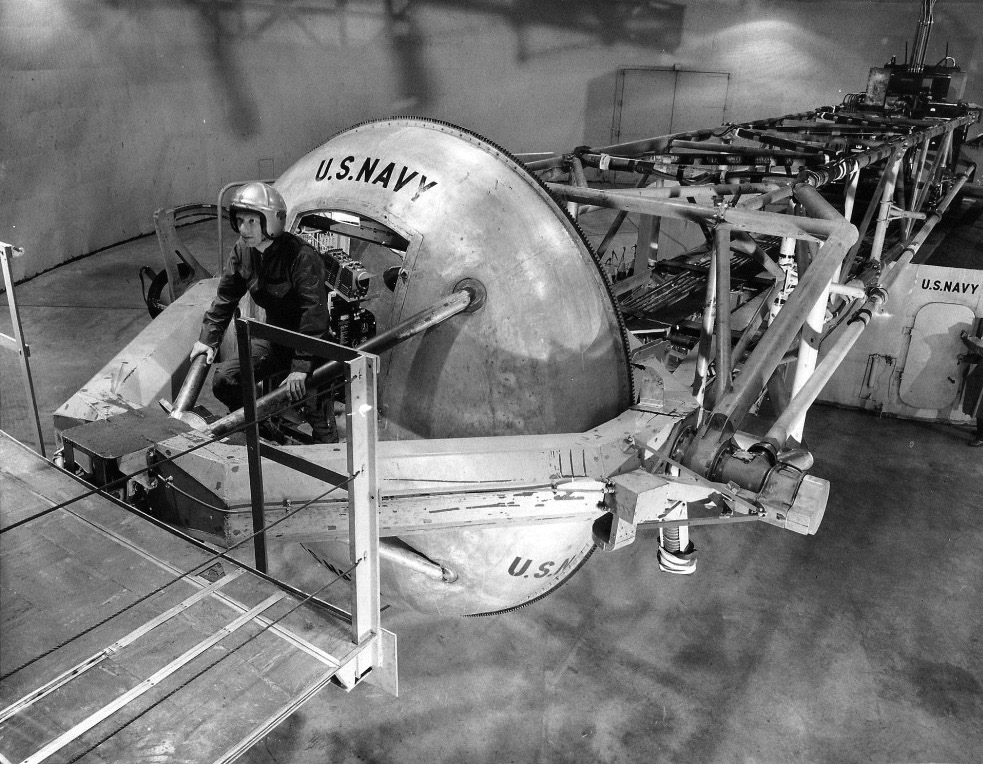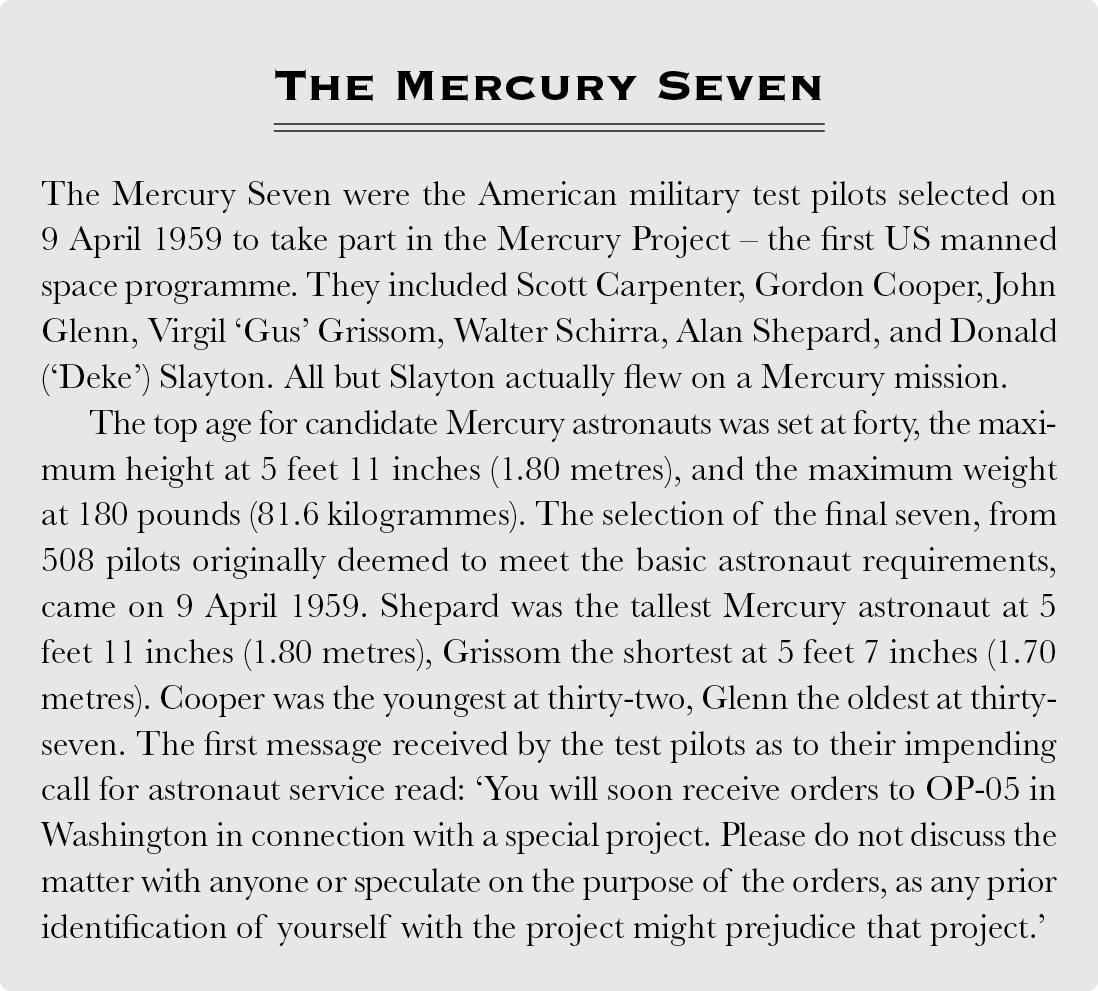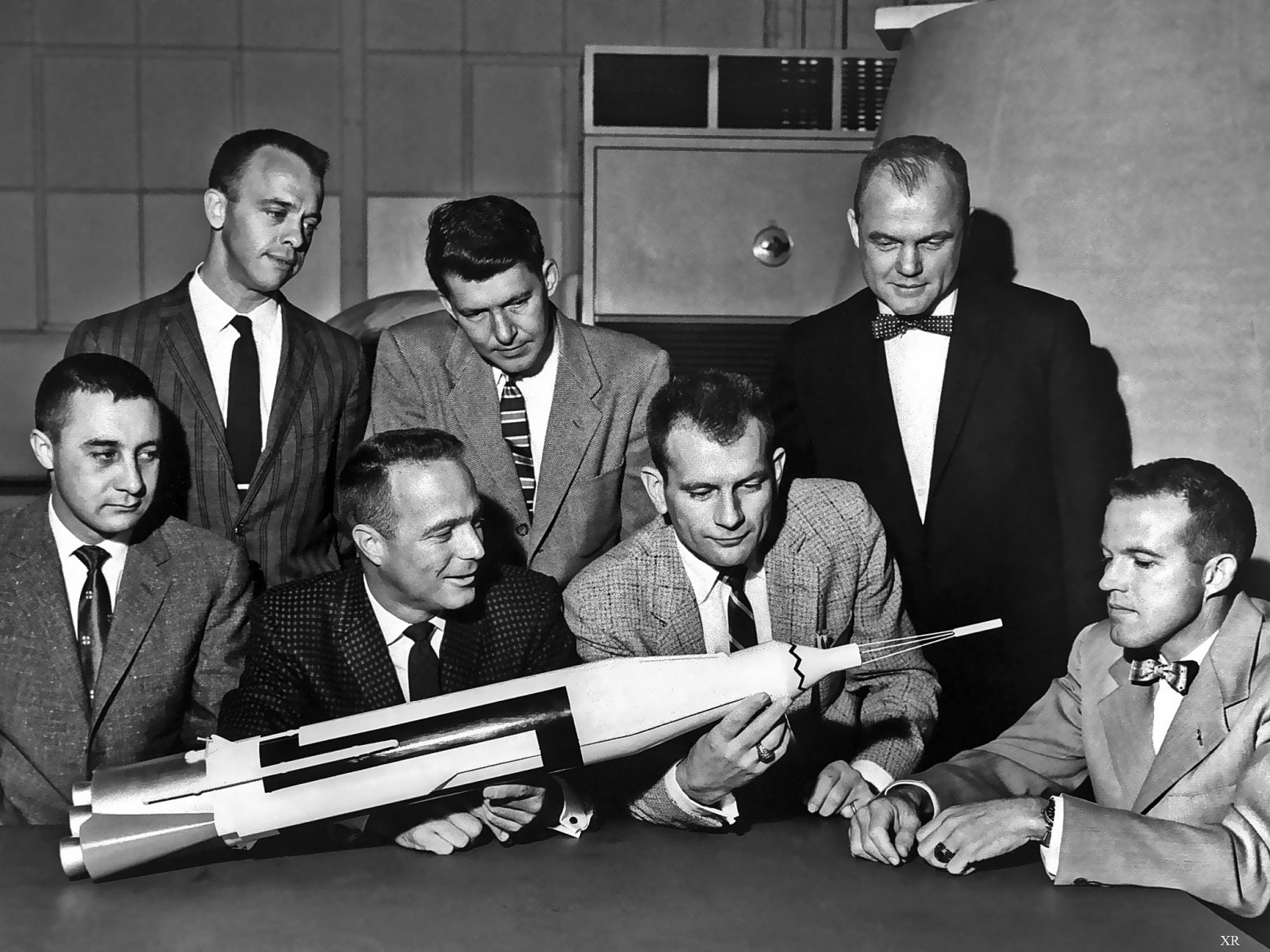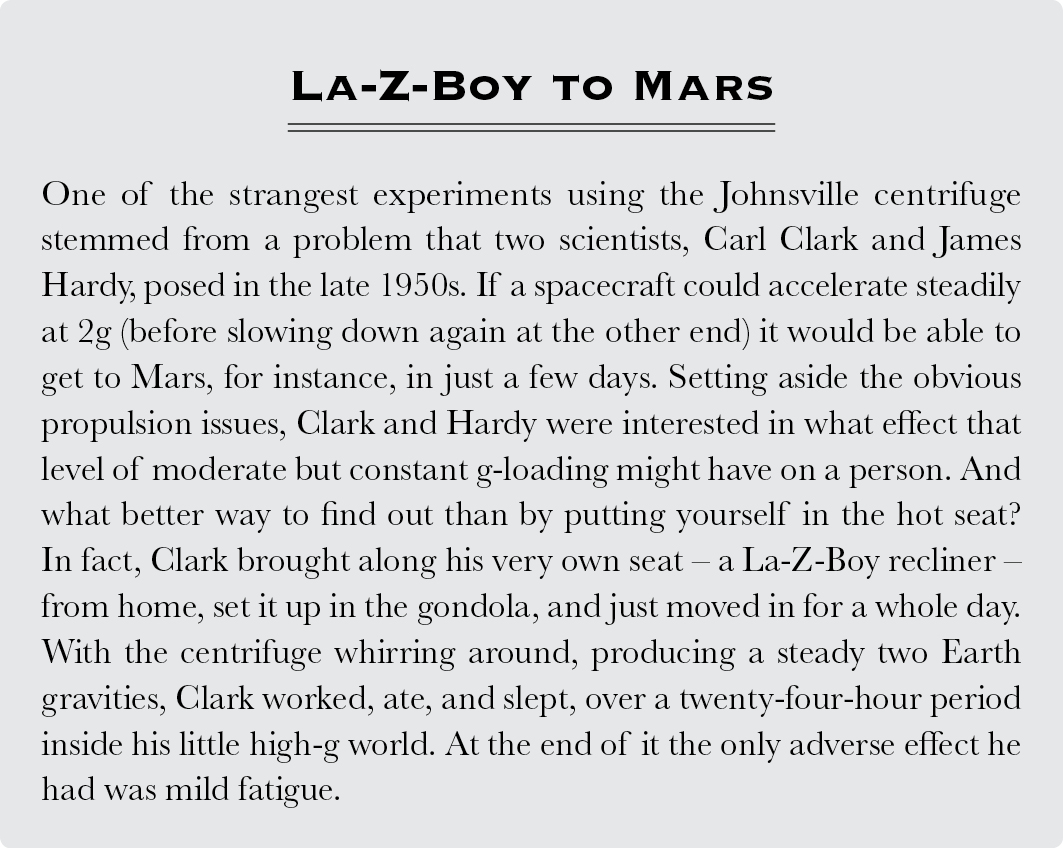10
Tested to
the Extreme

‘Sadistic’ and ‘diabolical’ – just a couple of the terms used by past astronauts to describe the most intimidating piece of apparatus they encountered in their training. Time magazine described it as ‘a gruesome merry-go-round’. The object in question was the Johnsville human centrifuge, the largest and most powerful machine of its kind on the planet.
Some of the people who rode most often in the Johnsville centrifuge, and subjected themselves to the most terrifying ordeals, weren’t celebrities like astronauts John Glenn or Alan Shepard. They were little-known physicians, engineers, and technicians – back-room guys – whose job it was to pave the way for tests on the pilots who would actually fly into space. Among these unsung volunteers were the medical technician Art Guntner and the psychologist R. Flanagan Gray, inventor of the ‘Iron Maiden’, an accessory to the infamous human centrifuge named, appropriately, after a medieval torture device.
Before the start of the Space Age, no one knew if the human body could stand up to the harsh treatment it would receive getting into and out of space, not to mention what the environment of space itself would do to a man or woman. In being blasted into orbit on top of a powerful rocket, an astronaut would feel, for minutes at a stretch, much heavier than on Earth. During re-entry, the g-forces would be even higher. Through experiments on the ground and the experiences of pilots during extreme aircraft manoeuvres, it was known that people could withstand brief exposure to very high g-force. But how much could space travellers take over longer periods, while accelerating into orbit and decelerating upon their return to Earth? And would they still be able to operate their vehicles?

27 The Johnsville centrifuge.
Whirled first
Early in the US space programme, the idea was entertained of using amusement-park rides, including roller-coasters and various spinning attractions, to study the effects on people of sustained acceleration. But it soon became obvious that only purpose-built machines would be able to deliver the intense and unusual types of stress that researchers wanted to study. Nothing less than a human-rated centrifuge would do – and that was just for starters. A whole demented playground of devices would eventually be needed to test future spacefarers to the limits of their endurance.
The first reasonably powerful human centrifuge had been built during the Second World War to help develop an effective anti-g suit. Canadian scientists Wilbur Franks and Frederick Banting, whose wartime research involved the problem of pilots blacking out or suffering G-LOC (g-induced loss of consciousness) when pulling high g-force, realized that testing new suits in real aircraft wasn’t an option. It was too dangerous, the experiment couldn’t be precisely controlled, and there was a security risk – as the g-suit project was top-secret. The human centrifuge, set up at the Canadian military’s Clinical Investigation Unit (CIU) in Toronto, was the perfect solution. It went into operation in mid-1941 and was supposed to be very hush-hush. However, it was pretty clear to everyone that something unusual was going on in the building where the device was housed. The 200-horsepower motor that drove it shared a power line with the rest of the neighbourhood, and every time it was fired up it drained current from the overhead lines supplying streetcars on the road outside so that they ground to a halt.
The CIU centrifuge had a round gondola hung from a horizontal arm that was attached to a vertical shaft. The motor spun the shaft, causing the gondola to swing out so that it was tilted at almost ninety degrees when moving fast – an arrangement familiar to anyone who has been on the fairground ride known as ‘the Enterprise’. The seat inside was like that of a fighter plane and suspended independently of the gondola, so that the rider could be positioned at different angles – even upside down to produce negative g.
An observer in the control room sent signals into the gondola by turning on lights and sounding a buzzer; the rider replied by switching the signals off. If he turned off only the buzzer it meant he was still conscious but had suffered a blackout – a total loss of vision. If he failed to turn off the lights or the buzzer, it was the sign that he had gone unconscious.
The results of the CIU centrifuge helped Franks to develop the first operationally practical g-suit. But the machine was also used to evaluate aircrew trainees – especially those suspected by their instructors of having a low tolerance to g loads. Quite possibly it saved a few lives by identifying unsuitable candidates who could then be moved out of pilot training before they got into trouble in the air.
Riding the wheel
Something on an altogether larger scale, though, was needed to prepare for America’s manned exploits in space. The Johnsville human centrifuge, at the Naval Air Development Center (NADC) in Warminster, Pennsylvania, just outside Philadelphia, would play a key role in testing astronauts for the Mercury, Gemini, and Apollo programmes. But its first objective, when it was completed in July 1950, was to study the effects of g-forces produced by high-performance aircraft and, in particular, to help train pilots for flying the X-15.
‘The Wheel’, as it was not-so-affectionately known, was housed within a round, cavernous, 11,000-square-foot building at the NADC (later renamed the Naval Air Warfare Center), a facility where the US Navy also modified aircraft before they joined the fleet and carried out weapons research. The site was chosen because the turning forces that the centrifuge could produce were so strong that the giant machine had to be anchored directly to bedrock to stop it shaking itself loose, and Warminster had some of the most stable bedrock that engineers could find.
The steel gondola of the centrifuge was shaped like a flattened sphere, measuring ten feet by six feet, and was mounted on a fifty-foot arm, at the other end of which was a 4,000-horsepower General Electric engine. So powerful was this motor that, flat out, it could whip the gondola to speeds of 175 miles per hour in just seven seconds, reaching a potentially deadly maximum of 40g. Equipped with dual gimbals, the gondola could be rotated so that the test subject was oriented in various positions relative to the applied g-force. Simply by turning the gondola as it spun about the arm, experimenters could subject pilots to positive g-force (with acceleration in a head-to-foot direction), negative g-force (foot-to-head, like that felt in a rapidly descending lift), transverse (chest to back), lateral (side to side), and practically every other variation that could crop up during a mission.
Naturally, it is the great test pilots and astronauts whose experiences on the centrifuge tend to be most heard about. But a lot of the time, the men who rode ‘the Wheel’ were ordinary staff members at Johnsville or other US Navy personnel who put themselves forward. The big names of aerospace were too busy flying to spend hour after hour being research guinea pigs, especially in the early days of the Wheel when its performance was being evaluated. That job fell instead to local volunteers such as aerospace medical technician Art Guntner who, in his time at NADC, climbed into the belly of the beast some 350 times and briefly soaked up to 15g of punishment – an acceleration that dwarfs the 4g to 6g max experienced aboard top-fuel dragsters, high-g roller-coasters, or even the Space Shuttle.
Born and raised in Morgantown, West Virginia, and hailing from a family with a long military tradition, Guntner joined the US Navy in 1958 and graduated from Aerospace Medicine School in 1960. Straight after that he was sent to NADC to work at the Aviation Medical Acceleration Laboratory, where the giant centrifuge was located. This was around the time that the first American astronauts-to-be were scheduled to begin tests on the machine.
The men – and they were all men (women having been excluded from the selection process) – chosen to take part in America’s first human space flights were known as the Mercury Seven. They were the elite corps who would fly aboard the cramped Mercury capsules that would be launched into space by Redstone and Atlas rockets.


28 The Mercury Seven astronauts with a model of an Atlas rocket. Standing, left to right, are Alan B. Shepard Jr, Walter M. Schirra Jr, and John H. Glenn Jr; sitting, left to right, are Virgil I. Grissom, M. Scott Carpenter, Donald (‘Deke’) Slayton, and L. Gordon Cooper Jr.
It was Guntner’s job to prep the Mercury Seven before they rode in the centrifuge. He helped brief them on the results of the early simulations and his own experiences at high-g. Another part of his job was to attach sensors to the astronauts before they were sealed inside the gondola, to monitor their heart rate and breathing. The gondola was kitted out with an instrument panel and hand controller just like that in the Mercury capsule, and could be depressurized to the actual flight pressure of five pounds per square inch. Test subjects would then report on how well they could use the controls while under high-g loading, and describe any adverse effects they felt. An especially valuable but frightening feature of the gondola was that it could be put into a tumble in which the accelerations might lurch gut-wrenchingly from positive 10g to negative 10g in roughly one second.
But there were lighter moments amid the stress and hard work. One weekend, Guntner was called in at short notice to work with the astronauts and, as his wife had other commitments, he had to bring his two-year-old daughter along with him. It proved to be a long, busy day with only a skeleton staff on duty, so Guntner had to rely on the only babysitters available – Alan Shepard and John Glenn.
For the Mercury astronauts, and, later, Gemini and Apollo astronauts, the Wheel was both a rite of passage and an essential training tool. ‘Whirling around at the end of that long arm, I was acting as a guinea pig for what a human being might encounter being launched into space or re-entering the atmosphere,’ John Glenn recalled in his autobiography. ‘You were straining every muscle of your body to the maximum … if you even thought of easing up, your vision would narrow like a set of blinkers and you’d start to black out.’
Under the crushing force of 6g, 8g, or even 10g, normal breathing isn’t an option. Exhaling is no problem but inhaling in the usual way, when it feels as if you weigh half a ton or more, is out of the question. ‘[I]t’s impossible to reinflate your lungs,’ wrote Apollo 11 Command Module pilot Michael Collins, ‘just as if steel bands were tightly encircling your chest. So you have to develop an entirely new method, keeping the lungs almost fully inflated at all times, and giving rapid little pants “off the top”.’

29 Alan Shepard poised on the step of the Johnsville centrifuge prior to a training run.
Subjects rode the centrifuge in one of two modes: closed-loop, in which the individual had full control over the movements of the gondola; and open-loop, or ‘meat in a seat’, in which the rider was more or less a lab rat. In every case, doctors monitored the progress of the ‘flight’, moment by moment, and both the subject and the support team could stop the ride immediately if there was a concern.
Pushing the envelope
Before anyone was allowed aboard the gondola for their first spin, they had to go through a battery of medical tests. The organ of most concern was the heart because it was entirely possible for someone to have an unsuspected heart condition, such as an arrhythmia, that might prove life-threatening if triggered by the stress of high g-force. In fact, an undiagnosed arrhythmia was triggered when Donald (‘Deke’) Slayton took a high-g ride, disqualifying him from astronaut duty in the Mercury Project (although he did eventually make it into space with the 1975 Apollo-Soyuz Test Project).
Those given the green light to ride varied a lot in how well they tolerated the g-forces of the Wheel. Some people not only coped well with the centrifuge, but strove to test its limits – and their own. One of these hardy souls was US Navy Reserve officer Carter Collins who, in August 1958, withstood a crushing 20g for six seconds, using a grunting technique to avoid blacking out and suffering chest pains. Later that day, R. Flanagan Gray, a civilian psychologist, repeated the feat.
Gray was one of the researchers at Johnsville trying to come up with new ways for astronauts to cope with high g-forces during take-off and re-entry. Some of the fruits of this work, such as contoured couches and special restraining straps, found their way into the actual spacecraft design; other ideas, although effective, weren’t used for practical reasons.
A lot of Gray’s experiments involved using animals instead of people and wouldn’t be allowed today. At the time, though, they would have seemed acceptable and Gray was known by his family as a kind and compassionate man. He would often bring home the animals used in his high-g tests to see if they could adapt as pets and live out the rest of their lives free of the trauma they’d had to endure at Johnsville. But it didn’t usually work out. On one occasion he brought back a goldfish after a multi-g whirl. It could only manage to swim upside down in its new home for a couple of days before it expired. It had been one of the earliest subjects to take a trip aboard one of Gray’s most memorable inventions – something menacingly called the ‘Iron Maiden’.

30 The ‘Iron Maiden’, a device patented by R. Flannigan Gray.
Early research with animals had shown that being immersed in water helped dissipate g-forces. Would it work with humans? To find out, Gray designed an aluminium capsule, sculpted roughly in the shape of a seated person, which could be filled with water and then attached to the centrifuge, giving the effect of being in a strange bathtub caught in a violent whirlpool. Into this, in March 1958, Gray climbed before being immersed up to his ribs and then spun around, lying down, head pointing in the direction of motion. On this first, semi-submerged trip, he took a full 16g without harm. The following year he entered the Iron Maiden again, for the ride of his life. This time he was seated facing backwards and totally immersed, at the last moment, so that the water was over the top of his head. Then, in an ordeal of which Harry Houdini would have been proud, he held his breath for twenty-five seconds while being spun crazily to a five-second peak of 32g – the most ever endured by a human in a centrifuge. Throughout the whole manic experience Gray remained conscious, although he did not emerge unscathed. He reported some sinus pain, but more seriously he received a hernia and suffered an eye injury that permanently affected his vision. After the ordeal, he was driven home in a black government car and could barely walk into his house.

Astonishingly, he was ready to take more but the experimental set-up couldn’t handle it. The Wheel could deliver up to 40g, but only at the end of its arm, inside the gondola. The Iron Maiden was too big to fit inside the gondola and so had to be mounted closer to the central axis, where 32g was the highest acceleration possible.
The scream machine
Only one other simulator rivalled the Wheel for extreme unpleasantness in the eyes of the Mercury Seven. Called the MASTIF (Multiple Axis Space Test Inertia Facility), it was located at NASA’s Lewis (now Glenn) Research Center in Cleveland, Ohio, and looked like something that a talented giant had made from a Tinker Toy set. It consisted of three concentric cages gimballed so that each could rotate about a different axis at right angles to the other two. At its core was a yoke that was twenty-one feet across that could support a 3,000-pound space capsule, which could be tumbled and turned in a noisy, incredibly dizzying way at up to sixty revolutions per minute. Its first job was to test the attitude control system of the Mercury capsule used for a flight called Big Joe 1 – an unmanned mission involving an Atlas booster to check out the capsule’s heat shield during re-entry.
An engineer at Lewis, James Useller, saw the potential for the MASTIF to be used for training astronauts in emergency situations. The unmanned capsule was replaced with a seat that was equipped on the arm rests with two hand controls linked to nitrogen thrusters. With the rig tumbling this way and that, the astronaut had the task of trying to right the device and keep it stable.
In mid-1959, Useller and a Lewis test pilot, Joseph Algranti, began taking cautious rides inside the MASTIF. Then they set up a formal test programme for about ten pilots and research scientists who wanted to see what effect rolling, pitching, and yawing at different speeds and for different lengths of time would have on a person. Beyond about thirty revs per minute, whirling around in three axes at once, everyone – including the most experienced pilots – suffered motion sickness. All was now ready for the Mercury Seven to take the fun ride.

31 The MASTIF (Multiple Axis Space Test Inertia Facility) at Lewis Research Center in 1960.
In February 1960, the first pair of Mercury astronauts, Gus Grissom and Alan Shepard, arrived in Cleveland for a week’s stay to test the MASTIF and their reactions to it. After a long previous session in which Shepard was strapped stationary in the seat of terror while the rig was made ready, he climbed back in for his first nausea-inducing spin. Within seconds of the MASTIF going into its horrible gyrations, an ashen-faced Shepard hit the red ‘chicken switch’, sounding a claxon horn as a signal to stop the ordeal. The next day Shepard – and before the end of March all the astronauts – endured runs at the full thirty revolutions per minute in all three axes and quickly learned, by using the hand controllers, to activate the thrusters, to halt their rotation and bring themselves to a stop while the cages continued to spin. The skill they picked up may have proved invaluable in an emergency, but one series on the MASTIF was enough. Reporters who watched a demonstration by Scott Carpenter afterwards gave vivid descriptions of the hapless astronaut’s piercing scream and the extraordinary contortions of this ‘ultimate’ in wild carnival rides.